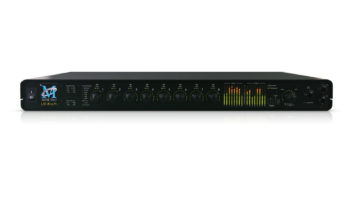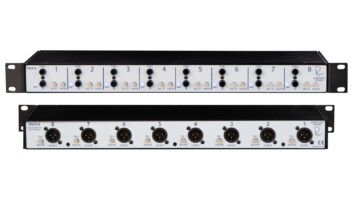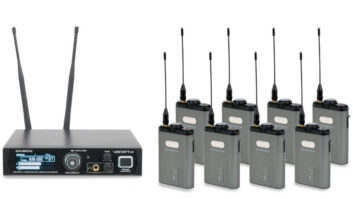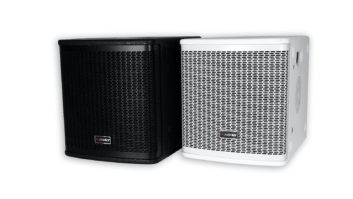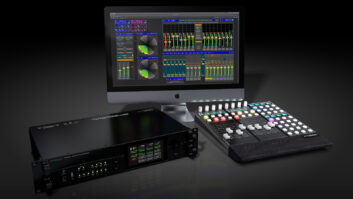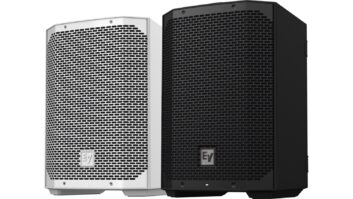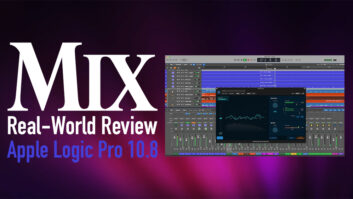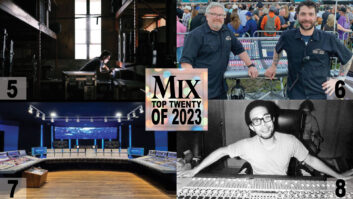I would hazard a guess that most studio engineers will notrecognize the D.A.S. name, as the Spanish company’s last studiomonitor was produced roughly 20 years ago. Established in 1970,D.A.S. began as a manufacturer of studio monitors before changingits focus to produce loudspeakers for sound reinforcementapplications. The company has returned to its roots with theintroduction of its Monitor line of near- to midfield recording andbroadcast studio monitors. The Monitor-8s and their smallersibling, the Monitor-6s, are the first offerings in the expandingproduct line. The larger Monitor-8s are reviewed here.
At $459 each ($918/pair), the Monitor-8s are modestly priced, soI was completely surprised by what I heard when I first auditionedthese superb passive monitors in my control room. In short, I wascompletely blown away. The Monitor-8s are world-class monitorsoffered at a bargain-basement price.
FIRST LOOK
Straight out of the box, the Monitor-8s are beautiful to behold.The heavily radiused side panels are fashioned from exotic Irokoplywood, adding rigidity as well as visual contrast to the black,15mm-thick MDF cabinet. This reinforcement minimizes colorationfrom panel vibration. The top and bottom edges of the cabinet arenot radiused. Cabinet dimensions (with a vertical orientation) are16.5×11×11.5 inches (H×W×D). Each cabinetweighs 28 pounds. The monitors are not magnetically shielded.
Behind the detachable, black cloth grille are twodrivers—an 8-inch polypropylene woofer with a rubber surroundand a 1-inch soft-dome, ultra-fine aluminum diaphragm tweeter. Thelow-frequency driver’s oversized motor structures and cast-aluminumchassis promise improved efficiency and impulse response. Thetweeter’s voice coils are Ferrofluid-cooled for maximum powerhandling and improved linearity.
The tweeter sits behind a protective fine-mesh metal grille.Both the tweeter and grille are inset in a Linear QuadraticSpherical™ waveguide, the curved shapethat reportedly reduces diffractive effects at high frequencies(the radiused side panels make a similar contribution). The resultis wider, more uniform imaging and less distortion due to combfiltering. The waveguide also increases the tweeter’ssensitivity.
A circular bass tuning port is on the rear panel, directlyopposite the high-frequency driver. Also on the rear panel are twobinding posts that provide power amp connections; these accept onlybare wire. Two M6 (metric 6) female mounting points are located onthe bottom of the cabinet that allows the monitors to be anchoredto a flat stand with a downward tilt.
SPECS
The Monitor-8s are rated at 125-watt RMS power, 250W programpower and over 500W peak power handling capability; D.A.S.recommends an amplifier rated at 125 to 250 watts at eight ohms.The specified peak SPL at full power is 116 dB, and I found astereo pair of Monitor-8s to be plenty loud when powered by my150-watt Hafler P-3000 Trans•nova amp. On-axis sensitivity (1watt/1 meter) is a respectable 89dB SPL.
The Monitor-8s’ frequency response is specified as 38 to 33 kHz(with no tolerances given). D.A.S. recommends you place theMonitor-8s four inches from a wall for added reinforcement of bassfrequencies, and a supplied chart shows the frequency response onewould ideally expect with such placement. The response is three dBsdown at 55 Hz and two dBs down at 20 kHz, with impressive linearityin between both extremes. (These measurements were made using a 1Wswept sine signal at one meter with the Monitor-8s in a half-spaceanechoic environment. The crossover point for the 12dB/octaveLinkwitz-Riley passive crossover is 3 kHz.
TESTING 1, 2, 3…
For reasons specific to my control room’s acoustics andergonomics, I placed the Monitor-8s about two feet from the nearestwall. D.A.S. recommends you orient the monitors vertically, and thenonconcentric arrangement of the drivers suggests this for optimalimaging. However, ergonomics directed me to orient the monitorshorizontally in my control room. Nevertheless, stereo imaging wasspectacular.
The Monitor-8s were installed into my Acoustic SciencesCorporation ATTACK Wall, a modular arrangement of cylindrical basstraps designed to soffit speakers and neutralize the acousticsignature of the front of the control room. Because the Monitor-8sare ported in the rear, the sidefill ASC StudioTraps™ and top MonitorTrap™ for each speaker were removed toallow low frequencies to vent back into the room to the mixposition.
For my critical listening tests, I listened to many of my recentmixes and favorite outside CD releases that I was intimatelyfamiliar with, spanning rock, pop, country, techno, grunge, folkand Celtic music styles. I was immediately struck by theMonitor-8s’ rock-solid stereo imaging, profound soundfield depth,open clarity and articulate detail. It was as if a veil had beenremoved from the mix, revealing hidden subtleties. The silky-smoothhigh end was sweet yet eminently articulate, without a hint ofstridency. Vocals sounded startlingly realistic, brimming over withunfettered nuance. Chimes and strummed guitar sounded downrightpalpable, with transients accurately and sweetly reproduced.Overall, the mids and highs were beautifully balanced andsmooth.
The only downside of how the Monitor-8s performed in my setupwas that lower bass frequencies—below roughly 80Hz—were reproduced rather weakly. No doubt this could havebeen improved by placement closer to a wall. And it must be saidthat most close-field monitors suffer the same weak bass, if oftenwith a somewhat lower cutoff. Switching in my Tannoy PS-88 activesubwoofer (a discontinued model) completely corrected theimbalance, and the Tannoy perfectly complemented the Monitor-8s. Infact, the Monitor-8s’ relatively high-bass roll-off keptinterference with the sub to a minimum, creating a more seamlesscoupling of the two systems.
With the sub added to the mix, drums sounded extremelyrealistic. Stick and kick drum beater strikes were beautifullydefined and the traps’ timbres perfectly balanced. Heaven.
I found the Monitor-8s to be very nonfatiguing without soundingeven slightly dark or veiled. Of course, the timbre wasunderstandably darker outside of the sweet spot, but the balancewas nevertheless easily workable.
CONCLUSIONS
Engineers looking to use the Monitor-8s as their main speakerswill want to add a subwoofer, especially if they can’t place thecabinets four inches from the wall, as the manufacturer suggests.But even without a sub, “mid-room” placement stillaffords an extremely accurate reference for checking stereo imagingand the spectral balance from the mid-bass frequencies on up. Thishas always been a near-field monitor’s raison d’être,and the Monitor-8s deliver in spades.
The Monitor-8s are one of the most detailed and transparentmonitors I’ve ever had the pleasure to work with. Imaging and depthare downright superb. As an added bonus, the monitors are reallyfun to listen to, without sacrificing accuracy.
With their first studio monitor offering in 20 years, D.A.S. hashit a grand slam home run over the center field fence. These areworld-class monitors at a dirt-cheap price, and there’s no way thatI’m going to relinquish them. My check is in the mail!
Dist. by Sennheiser, 1 Enterprise Dr., PO Box 987, Old Lyme, CT06371; 860/434-9190; fax 860/434-1759; www.dasaudio.com.
Michael Cooper is a Mix contributing editor andowner of Michael Cooper Recording in beautiful Sisters,Ore.
